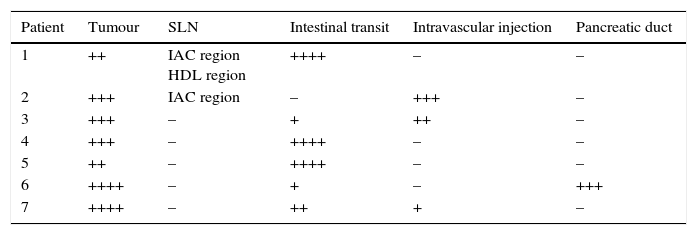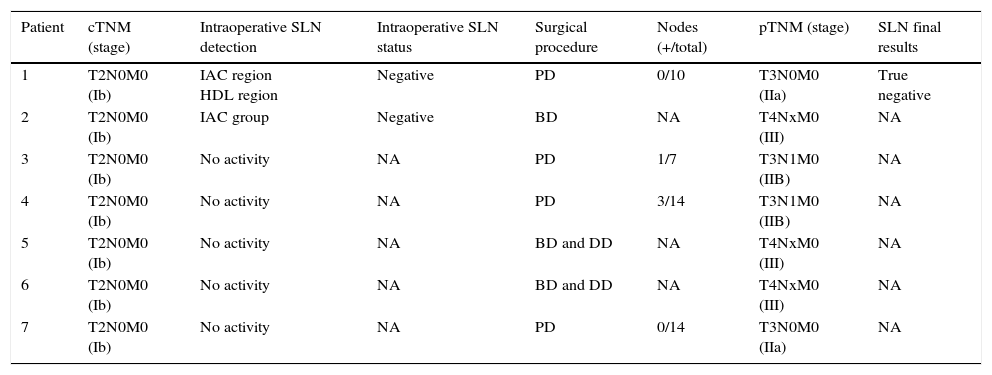The local recurrence of pancreatic cancer is around 30% when complete resection can be achieved. Extended lymphatic resections may improve survival, but increases severe morbidity. As accurate patient selection should be mandatory, a new method is presented for pancreatic sentinel lymph node (SLN) detection with lymphoscintigraphy and gamma probe.
Materials and methodsSeven patients with cT2N0M0 pancreatic head cancer were enrolled between 2009 and 2012 in this prospective study. One day prior to surgery, preoperative lymphoscintigraphy with echoendoscopic intratumoural administration of Tc99m-labelled nanocolloid was performed, with planar and SPECT-CT images obtained 2h later. Gamma probe detection of SLN was also carried out during surgery.
ResultsRadiotracer administration was feasible in all patients. Scintigraphy images showed inter-aortocaval lymph nodes in 2 patients, hepatoduodenal ligament lymph nodes in 1, intravascular injection in 3, intestinal transit in 5, and main pancreatic duct visualisation in 1. Surgical resection could only be achieved in 4 patients owing to locally advanced disease. Intraoperative SLN detection was accomplished in 2 patients, both with negative results. Only in one patient could SLN be confirmed as truly negative by final histopathological analysis.
ConclusionsThis new method of pancreatic SLN detection is technically feasible, but challenging. Our preliminary results with 7 patients are not sufficient for clinical validation.
Tras una resección quirúrgica completa, la recidiva local del cancer de páncreas es de aproximadamente el 30%. La linfadenectomía extendida podría mejorar la supervivencia pero implica una morbilidad grave, por lo que una adecuada selección de los pacientes seria fundamental. Presentamos una nueva técnica de determinación del ganglio centinela (GC) en el cáncer de páncreas mediante el uso de SPECT/TC y sonda gamma.
Materiales y MétodosSiete pacientes con cáncer de páncreas estadío cT2N0M0 fueron incluidos entre 2009 y 2012 en este estudio prospectivo. El día antes de la cirugía se realizó una ecoendoscopia con inyección intratumoral de un nanocoloide marcado con Tc99m y dos horas más tarde se obtuvieron imágenes planares y de SPECT-TC. Intraoperatoriamente se realizó asimismo un rastreo con sonda gamma para detectar el GC.
ResultadosLa administración del radiotrazador fue posible en todos los pacientes. La linfogammagrafía detectó ganglios interaortocavos en 2 pacientes, ganglios en el ligamento hepatoduodenal en 1 paciente, inyección intravascular en 3 pacientes, tránsito intestinal en 5 pacientes y visualizó el conducto pancreático principal en 1 paciente. Debido a la progresión local, la resección quirúrgica pudo ser completada únicamente en 4 pacientes. La detección intraoperatoria del GC se completo en 2 pacientes, ambos con resultado negativo. Sólo en uno de estos pacientes el resultado pudo confirmarse con el estudio anatomopatológico definitivo.
ConclusionesEste nuevo método de detección del GC en cáncer de páncreas es viable pero complejo. Nuestros resultados preliminares con 7 pacientes no permiten una validación clínica.
Article
If you experience access problems, you can contact the SEMNIM Technical Secretariat by email at secretaria.tecnica@semnim.es or by phone at +34 619 594 780.

Revista Española de Medicina Nuclear e Imagen Molecular (English Edition)












